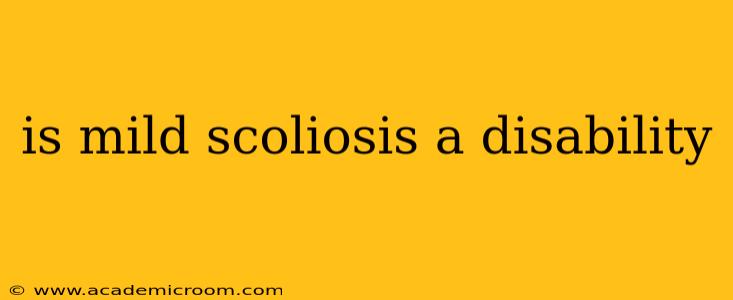Is Mild Scoliosis a Disability? Navigating the Complexities of Diagnosis and Impact
Scoliosis, a sideways curvature of the spine, affects millions worldwide. While many cases are mild and require no treatment, the question of whether mild scoliosis constitutes a disability is nuanced and depends on several factors. It's not a simple yes or no answer. This article will explore the complexities surrounding this question, addressing common concerns and providing clarity.
What is Considered Mild Scoliosis?
The severity of scoliosis is measured using the Cobb angle, determined through X-rays. Generally, a Cobb angle of less than 25 degrees is considered mild scoliosis. Individuals with mild scoliosis may experience minimal or no symptoms. However, this doesn't automatically disqualify it as a potential disability.
H2: Can Mild Scoliosis Affect Daily Life?
This is a crucial point. While some individuals with mild scoliosis live completely symptom-free lives, others might experience:
- Back pain: This can range from mild discomfort to significant pain, impacting daily activities and work performance.
- Fatigue: The body may expend extra energy to compensate for the spinal curvature, leading to increased fatigue.
- Limited range of motion: Depending on the location and severity of the curve, movement might be restricted.
- Respiratory issues (in severe cases): While less common with mild scoliosis, significant curves can affect lung capacity.
- Psychological impact: The visible nature of scoliosis, even if mild, can affect body image and self-esteem.
The extent to which these symptoms impact daily life varies widely. For some, the effects are negligible. For others, the pain, fatigue, or limitations could significantly hinder their ability to work, study, or participate in daily activities.
H2: How is Mild Scoliosis Classified as a Disability (if at all)?
The determination of whether mild scoliosis qualifies as a disability relies heavily on the individual's specific circumstances and the impact it has on their life. It's not a diagnosis-based determination but rather a function of the functional limitations. Disability assessments typically consider:
- The severity of the symptoms: The extent to which pain, fatigue, or limited mobility interfere with daily functioning.
- The individual's functional limitations: Can they perform everyday tasks, work, or participate in social activities without significant difficulty?
- The need for accommodations: Do they require assistive devices, modifications to their workspace, or other accommodations to participate fully in society?
Disability determination varies by country and jurisdiction, following different criteria. In some cases, mild scoliosis might be considered a disability if it substantially limits one or more major life activities, such as working, lifting, or walking. In others, it might not be recognized as a disability unless accompanied by significant functional limitations.
H2: Does Mild Scoliosis Qualify for Disability Benefits?
This depends entirely on the specific criteria of the disability benefits program in question (e.g., Social Security Disability Insurance in the US, similar programs in other countries). The key is demonstrating that the scoliosis, even if mild, causes significant functional limitations that prevent the individual from engaging in substantial gainful activity. Medical documentation from a physician is crucial in this process. A simple diagnosis of "mild scoliosis" is usually insufficient; the documentation must clearly link the condition to specific functional limitations.
H2: What about accommodations in the workplace or educational settings?
Regardless of disability classification, individuals with mild scoliosis may be entitled to reasonable accommodations in their workplace or educational setting under laws such as the Americans with Disabilities Act (ADA) in the US. These accommodations might include:
- Ergonomic adjustments: Modifying workstations to provide better support and reduce strain on the back.
- Modified work schedules: Allowing for more frequent breaks or adjustments to working hours.
- Assistive devices: Providing back supports or other aids to improve comfort and functionality.
H2: When should I seek medical attention for mild scoliosis?
Even with mild scoliosis, regular monitoring by a physician is recommended. If you experience worsening pain, increased fatigue, or any new symptoms, it is vital to consult your doctor. They can assess your condition, determine the need for treatment, and advise on appropriate management strategies.
Conclusion:
Whether mild scoliosis is considered a disability is highly individual and context-dependent. While the curvature itself might not automatically qualify as a disability, its impact on an individual's daily life and functional abilities is the key determinant. A thorough assessment by a healthcare professional and a careful consideration of the specific limitations experienced by the individual are crucial for accurate classification and access to appropriate support and accommodations. Always consult with a qualified medical professional for personalized advice and guidance.
